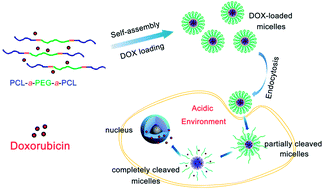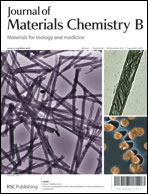Biocompatible and acid-cleavable poly(ε-caprolactone)-acetal-poly(ethylene glycol)-acetal-poly(ε-caprolactone) triblock copolymers: synthesis, characterization and pH-triggered doxorubicin delivery†
Abstract
A series of acid-cleavable ABA-type triblock copolymers, namely poly(ε-caprolactone)-acetal-poly(ethylene glycol)-acetal-poly(ε-caprolactone) (PCL-a-PEG-a-PCL), were synthesized via a combination of ring-opening polymerization (ROP) of ε-caprolactone initiated by propargyl alcohol and subsequent “CuAAC” click reaction with azide terminated acetal-containing poly(ethylene glycol). The chemical composition and structures of the copolymers were characterized by 1H NMR and FT-IR spectroscopy, while their molecular weights and molecular weight distributions were measured by gel permeation chromatography (GPC). The critical aggregation concentration (CAC), size parameters and morphologies of micelles self-assembled from PCL-a-PEG-a-PCL were determined by fluorescence probing, dynamic light scattering (DLS), and transmission electron microscopy (TEM), respectively. Since the acetal groups are unstable in weak acidic media, it is anticipated that this class of triblock copolymer micelles can be dissociated in an intracellular environment. This was confirmed by monitoring the size change of micelles with the increase of degradation time under acidic conditions, as well as the molecular weights of degradation products. The pH-triggered release of doxorubicin (DOX) from PCL-a-PEG-a-PCL micelles was studied and compared with a pH-insensitive PCL-b-PEG-b-PCL system without acetal groups, demonstrating that the cleavage of acetal linkages was responsible for the pH-responsive drug release profiles. In vitro cytotoxicity tests against HeLa and L929 cells by MTT assays indicated that the self-assembled micelles displayed very low cytotoxicity. In addition, the intracellular drug release against HeLa cells was further investigated by a live cell imaging system using free DOX as a control. This work provides a facile strategy for the preparation of a new type of biodegradable amphiphilic copolymer as a highly promising intracellular delivery system for hydrophobic drugs.


 Please wait while we load your content...
Please wait while we load your content...